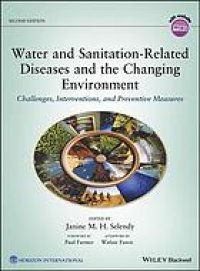"Meeting water and sanitation needs, coupled with protection of the environment and prevention of pollutants, is essential to every effort to improve the health and living conditions of billions of people. Meeting these needs is fundamental, not only to effectively diminish incidence of diseases that afflict a third or more of the people of the world, but also to improve education and economic well-being and elevate billions of individuals out of vicious cycles of poverty." These lines are from the Introduction to the First Edition of "Water and Sanitation Related Diseases and the Environment: Challenges, Interventions and Preventive Measures" written by Jens Aagaard- Hansen and Janine M.H. Selendy. The Second Edition will continue to address these goals in updated and revised chapters and new ones with an added emphasis on the current and anticipated impact of climate change. Preparatory measures and preventive measures and solutions will be presented providing guidance for possible action on the local, national and international levels. Consistent with the First Edition, this volume is being written by authorities from the fields of public health, medicine, epidemiology, environmental health, climate change, nutrition and malnutrition, environmental engineering, pharmacology, and population research to provide an interdisciplinary picture of conditions responsible for water and sanitation-related diseases and measures for prevention. Written taking into account the dynamic changes being brought about by climate changes, this book further examines the pathogens and their biology, morbidity and mortality resulting from lack of safe water and sanitation, changing distribution of these diseases, and the conditions that must be met to reduce or eradicate them. The scope of the volume will once again be international discussing anthropogenic and naturally occurring pollutants, pharmaceuticals, agricultural productivity, migration, nutrition, ecosystem dynamics, and the other areas addressed in the First Edition. The addition of Climate Change in the title is to emphasize that this vital subject will be addressed throughout the volume, including receiving special coverage in a chapter on climate change and human health, because of the importance of addressing current and anticipated changes due to climate change even more so than to the extent related concerns were raised in the First Edition thanks to added knowledge now available. Transformations now apparent and expected from climate change along with other dynamic changes in health and environmental influences throughout the world are part of the reality that has motivated authors from the First Edition and a new author, thus far, who are now writing eighteen chapters for the Second Edition. The realization of the widespread use of the current volume and its accompanying material has, naturally, been a major factor in encouraging their participation. It is imperative that discussion of water and sanitation- related diseases and interconnected environmental concerns be approached from a multi-factorial perspective. This involves discussion of water access and quality, sanitation and hygiene, specifics about the most prevalent diseases, and environmental factors, and guidelines and solutions. The First Edition begins to fill that niche in a format conducive to continuing discussion and graduate education, and that provides guidance with examples of successful preventive measures and interventions. The Second Edition will not only build on the substantial coverage of the First Edition, but also add new emphasis on climate change and the international nature of many of the diseases and pollutants discussed such as cryptosporidiosis, giardia, lead poisoning, harmful algal blooms, malnutrition and undernutrition, and soil- transmitted helminths (or worms). This will include coverage of the huge human migrations and the problems they face, the effects of population on the depletion of fresh water, and urban situations. Efforts underway to meet the new Sustainable Development Goals, reduce open-defecation, and to address crumbing infrastructures in many parts of the world, are among the features of the revised content. Pollution from pharmaceuticals addressed in the First Edition will also cover anti-biotic resistance which was covered in a separate chapter. Content will include updated chapters on the successful initiatives in Mexico "Extending the Right to Health Care and Improving Survival in Mexico" and on the eradication of Guinea worm, now down to less than 500 cases in the world. New coverage of successful sanitation and hygiene initiatives will feature the many successful installations and use of facilities underway thanks to the Water Supply and Sanitation Collaborative Council (WSSCC), and its Global Sanitation Fund"--Provided by publisher. Read more...
